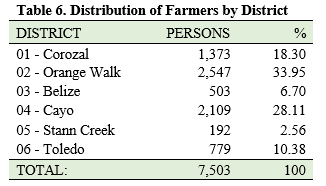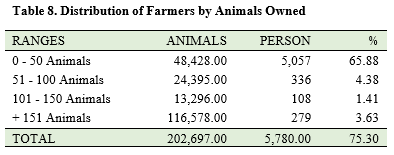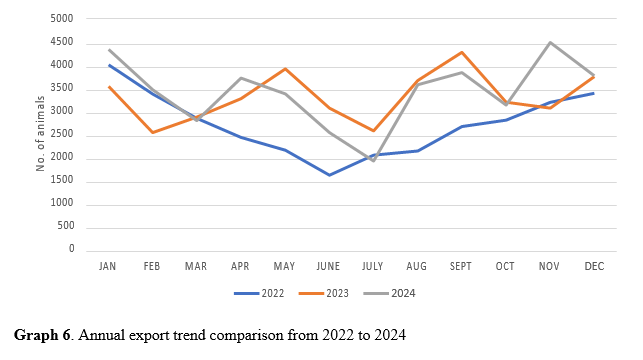BLR Statistics & Highlights
Farmers & Establishments
At the end of the year 2024 (Table 6), the total active farmers recorded in the BLR was 7,503. Compared to 2023, the BLR had 6,808 farmers, a 695 farmer increase in 2024.
Furthermore, out of the total active farmers, 6,203 (82.67%) are males and 712 (9.49%) are females, with the highest concentration of farmers in Orange Walk (2,547) followed by Cayo (2,109) respectively. Orange Walk comprised of the largest number of farmers in the entire country which adds up to 33.95% of cattle ranchers


With regards to number of cattle heads per farmer, it can be observed in Table 8 that 65.88% (5,057) of the industry can be classified as small farmers who owns between 1 to 50 animals, whilst only 3.63% of the farmers are within the large farmer category and have 150 plus
animals. Of note is the total 5,780 farmers identified with animals within the BLR System. Within the BLR, there are farmers that do not have animals, some buy and sell only, while others are institutions or slaughterhouses.
Table 7 illustrates the distribution of farmers by district including gender. In 2024 we ended with 6,203 male farmers and 712 female farmers. We have of the livestock farmers being males and 4% females. At the time of registration, 588 farmers did not include their sexual identification.

National Herd
Table 9 shows the distribution of the National Herd by Age. This illustrates a young cattle population of approximately 38% being less than 3 years old (i.e. 36 months) while 17% are 10 years old or more. Total herd population within the BLR is at 202,697 with 154,908 or 76% being female and 47,347 or 24% being male with 442 or 0.2% registered as castrated male animals.


Table 10 shows the distribution of animals by district. Orange Walk continues to have the highest concentration of cattle in 2024 followed by Cayo. The northern two districts combined for a total of 114,815 animals or 56.6% of all the animals within the country. This is followed by the Cayo district with 28.7% of the total cattle population. Toledo is the district with the third highest cattle population with 6.5%.
National Slaughter/Consumption
According to the BLR records, 10,500 animals were slaughtered or otherwise consumed locally in 2024 with March being the highest month of consumption with 1,087 animals and April the lowest at 716 animals. A comparative trend in the graph below shows beef slaughter record from 2023 through 2024. There has been an uptake in cattle slaughtered from 2023 at 9,266 unit of animal to 10,500 unit of animal in 2024, which represents an 11.8 % increase. Interestingly, the first quarter of the year (i.e. January through March) seems to be when the highest slaughtering of beef occurs and hence the highest period of expected beef consumption in Belize.

Cattle Export Report
Table 11 shows the monthly exports to Guatemala and Mexico respectively for the 2024 calendar year along with the consolidated total for both Mexico and Guatemala. In 2024 the livestock farmers exported a total of 41,515 animals. A total of 35,351 animals were exported to Guatemala and 6,164 to Mexico. As shown in the table, approximately 85.2% of those animals went to the Guatemalan market while 14.8% was exported to the Mexican market.

Total yearly export comparison between 2023 and 2024 revealed an increase from 40,290 animals exported in 2023 versus 41,515 in 2024. This is an increase in export in 2024 of 1,225 animals or 3% versus 2023.

The line graph below shows a yearly cattle export comparison for the past three years: 2022, 2023 and 2024. The exports have increased annually: Yr 2022 = 33,197animals; Yr 2023 = 40,290 animals and Yr 2024 = 41,515 animals.
The trend indicated a similar pattern of cattle movement throughout the year for both 2023 and 2024 compared to 2022. January through March is expected to see a reduction in export as farmers generally holding their animals to increase weight gains before selling in March as pasture is abundant during this period. As of March, the dry period sets in and hence pasture availability starts declining and so does the price per pound of cattle for the export market. In both 2023 and 2024 we saw a recurring uptake in export during the months of August and September and again in November for 2024 only.

